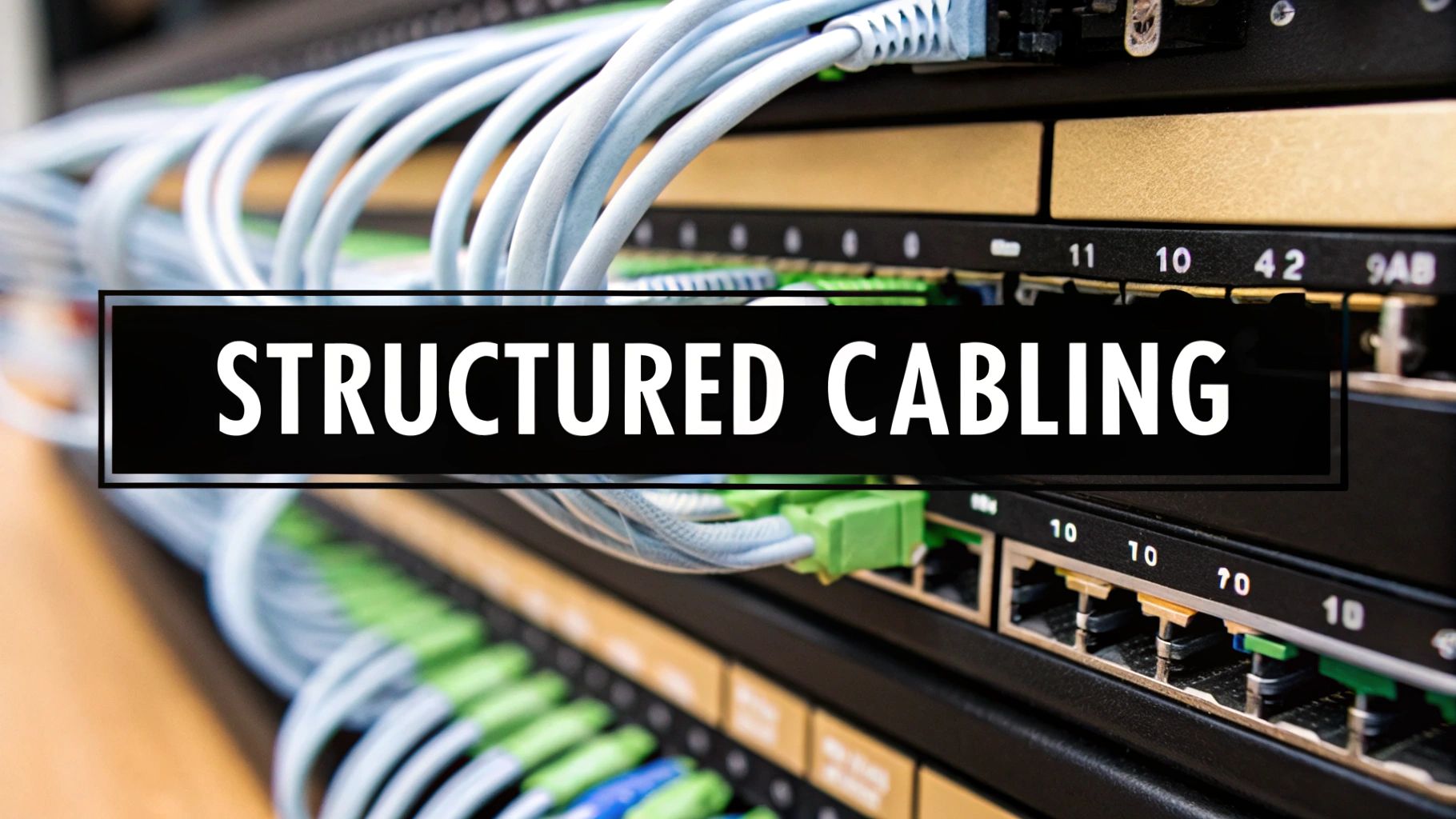Think of the last time you saw the back of a TV stand or a computer desk from 20 years ago. Remember that tangled, chaotic mess of wires? That’s what many business networks look like behind the scenes—a “spaghetti” of cables that’s impossible to manage. Structured cabling is the exact opposite. It’s a methodical, organized approach to your building’s communication infrastructure.
This system is the backbone for all your data, voice, and video traffic. It’s less about just connecting devices and more about creating a clean, logical, and future-proof framework for everything your business does.
From Cable Chaos to Organized Control
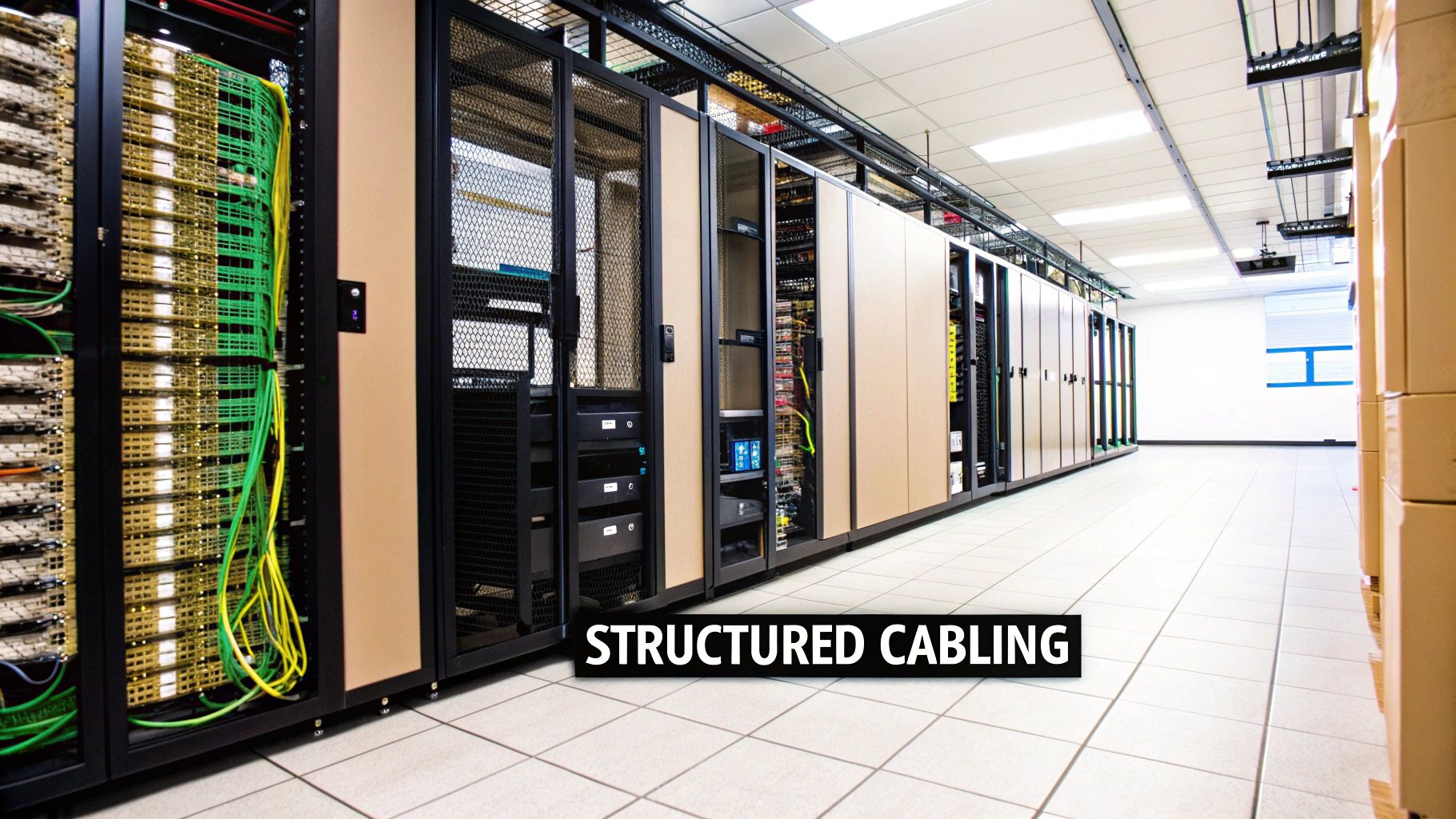
Let’s be honest, the old way of wiring an office was a mess. Known as point-to-point (P2P) wiring, it involved running a dedicated cable directly from one device to another. It sounds simple enough for a two-person office, but it quickly spirals into an unmanageable disaster as you grow.
Every new computer, phone, or printer adds another wire to the tangled web, snaking through walls and ceilings. When something goes wrong, troubleshooting becomes a nightmare of guesswork. This approach just doesn’t scale.
Structured cabling is the modern, forward-thinking solution. It’s a master plan for your network, built around a system of organized patch panels, outlets, and dedicated pathways.
Think of it like this: A point-to-point network is like running a separate extension cord from the power pole outside to every single appliance in your house. Structured cabling is like having a properly installed electrical system with a breaker box, organized circuits, and wall outlets exactly where you need them.
This organized foundation ensures all your technology—from cables and patch panels to wall plates—works together flawlessly. It’s clean, predictable, and built to last.
The Problem with Disorganized Wiring
Relying on a messy, undocumented P2P system isn’t just an inconvenience; it’s a real business liability. This outdated method almost always leads to major headaches.
A clear way to see the difference is to compare the two approaches side-by-side.
Structured Cabling vs Disorganized Wiring
| Feature | Structured Cabling | Disorganized Wiring |
|---|---|---|
| Organization | Clean, labeled, and documented system using patch panels and dedicated pathways. | Chaotic “spaghetti” mess of wires with no clear organization or labels. |
| Scalability | Easy to add or move devices. Changes take minutes by swapping patch cords. | Very difficult to scale. Adding a new connection is a disruptive, costly project. |
| Troubleshooting | Fast and efficient. Technicians can quickly isolate and fix issues. | A nightmare. Tracing a single faulty cable can take hours or even days. |
| Performance | Reliable and consistent network speeds with minimal electronic interference. | Prone to slow speeds and dropped connections due to signal crosstalk and damage. |
| Cost | Higher initial investment but lower lifetime operational and maintenance costs. | Low upfront cost but extremely high costs for moves, adds, changes, and downtime. |
| Safety | Neat cable management reduces tripping hazards and improves airflow around equipment. | Poses significant safety risks, including tripping hazards and fire code violations. |
Ultimately, the choice comes down to investing in a robust foundation or constantly patching a failing one. The long-term benefits of an organized system far outweigh the initial setup cost.
The Superiority of a Structured System
A structured cabling system is engineered for performance, reliability, and longevity. It’s built with the future in mind, anticipating growth and new technologies. Need to add a new employee or reconfigure an office space? It’s as simple as moving a short patch cord in a telecommunications closet. The whole process takes minutes, not days, with zero disruption to your business.
This is the unseen engine that powers everything your business relies on—from computers and VoIP phones to security cameras and wireless access points. It’s the key to keeping your operations running smoothly and efficiently.
The Six Core Subsystems of a Cabling Network
To really understand what structured cabling is, you have to look at how it’s put together. It’s not just a big bundle of wires; it’s a highly organized system. Think of it like the different systems in a building—plumbing, electrical, HVAC—each with a specific job. Industry standards, mainly from groups like the Telecommunications Industry Association (TIA), break a structured cabling system into six distinct parts, or subsystems.
Each of these subsystems has a dedicated role, ensuring data moves efficiently from the outside world to every single desk in your office. Let’s walk through them one by one.
1. The Entrance Facility
The Entrance Facility (EF) is exactly what it sounds like: the point where all external communication services enter your building. This is where the cables from your internet service provider (ISP) or phone company physically connect to your internal network.
This spot contains the demarcation point, or “demarc,” which is a crucial line in the sand. It’s where your service provider’s responsibility ends and yours begins. The EF also houses all the necessary hardware, circuit protectors, and grounding equipment to bring those outside signals safely into your building.
2. The Equipment Room
If the Entrance Facility is the front door, the Equipment Room (ER) is the central command center. This is a dedicated, climate-controlled space that houses the heart of your network. Your main servers, routers, core network switches, and other critical hardware all live here.
Because this equipment is so vital (and often expensive), the ER is designed for security and proper cooling. It’s the central hub where everything else connects, making it the brain of the entire operation.
The Equipment Room is the main distribution hub for all your voice and data traffic. It takes in information, processes it, and sends it exactly where it needs to go—much like a brain sending signals to the rest of the body.
The investment in this kind of core infrastructure is massive and growing. The U.S. market alone was valued at around $3.33 billion in 2024 and is projected to hit nearly $9.50 billion by 2034, growing at a rate of over 11% each year. This boom is fueled by our reliance on cloud computing, ever-increasing data traffic, and the constant demand for faster connections. You can dig deeper into these trends in this detailed structured cabling market analysis.
3. Backbone and Horizontal Cabling
These two subsystems are the highways and local roads of your network, moving data between key points and out to the end users.
- Backbone Cabling: Sometimes called vertical cabling, this is the information superhighway connecting your main Equipment Room to smaller Telecommunications Rooms, often running between floors. Because it has to handle so much traffic, backbone cabling is almost always high-capacity fiber optic cable.
- Horizontal Cabling: This is what gets the connection from the Telecommunications Room to the individual workstation outlet on your wall. Think of these as the local streets that branch off the main highway, running through ceilings or under floors to deliver the signal directly to your desk.
4. The Telecommunications Room
A Telecommunications Room (TR)—you might also hear it called a telecommunications closet—is a mini-hub for a specific floor or section of a building. It’s the meeting point where the main backbone cabling connects to all the horizontal cables for that area.
Inside a TR, you’ll find patch panels and switches that manage local connections. This design is a lifesaver for IT teams. If someone loses their network connection, a technician can troubleshoot the problem within that floor’s TR instead of having to trace a single cable all the way back to the main Equipment Room.
This image shows how all these organized pieces come together to provide real business benefits.
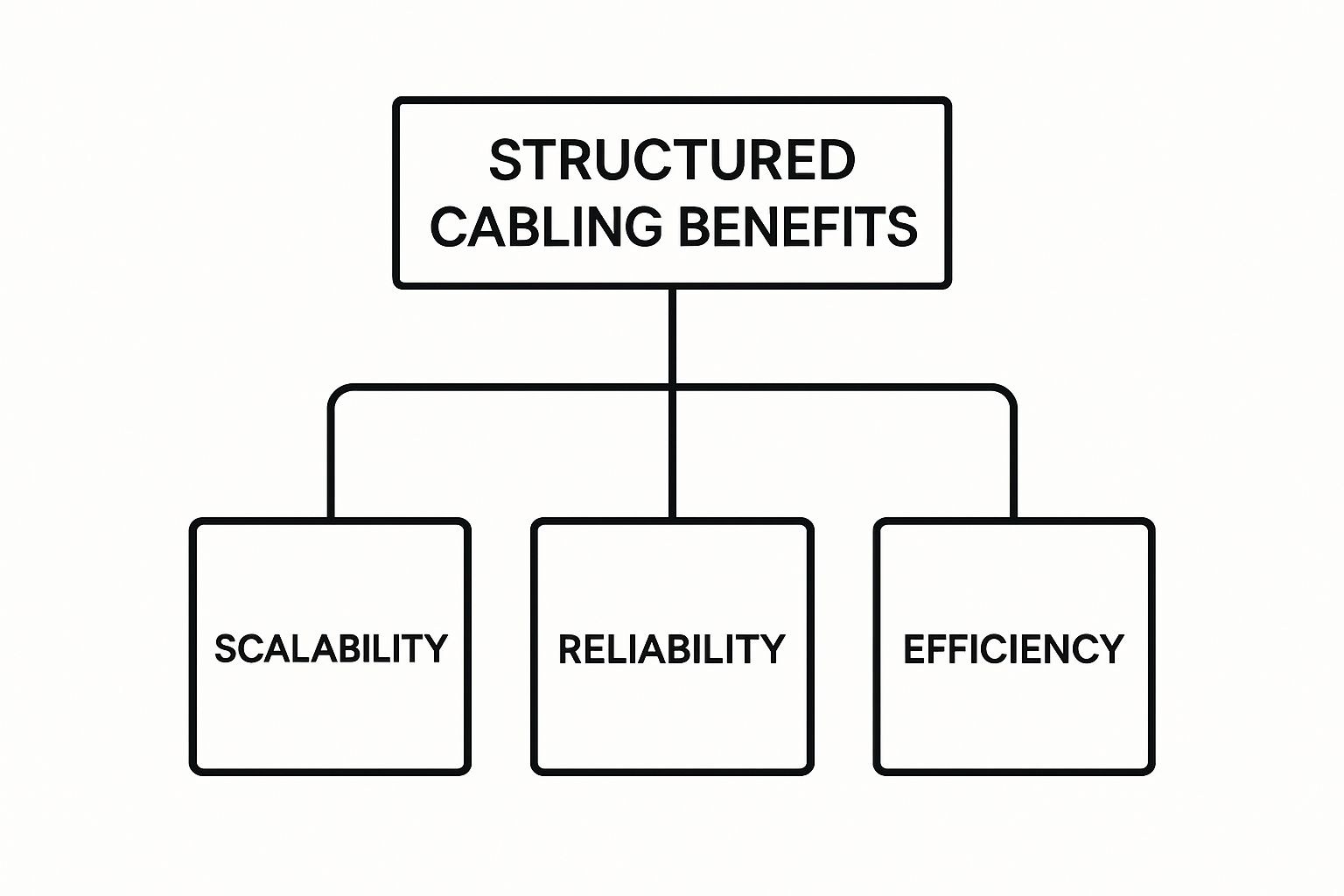
The organized, top-down structure makes it clear how a well-designed system delivers on its promises of reliability and simplicity.
5. The Work Area
Finally, we arrive at the Work Area (WA). This is where you, the end-user, actually interact with the network. It’s your desk, your cubicle, your office—the final destination for all that carefully routed data.
The Work Area includes all the components that bridge the gap from the wall to your computer:
- The wall plate with its network jack (the outlet).
- The patch cable you plug into the wall and your device.
- Any adapters needed to connect your phone, computer, or other equipment.
Each of these six subsystems plays a vital role. Together, they form a logical, powerful, and scalable foundation that quietly supports almost everything a modern business does.
Real-World Business Benefits You Can Measure
Let’s cut through the technical jargon for a moment. As a business owner or IT manager, you’re probably asking the most important question: “Why should I spend money on this?” The answer isn’t just about tidying up wires; it’s about real, measurable improvements to your bottom line, daily operations, and ability to grow. Moving away from a tangled, unpredictable network is a smart strategic move, not just an aesthetic one.
When your network infrastructure is organized, everything runs more smoothly. You stop putting out network fires and start managing a logical, predictable system. This clean foundation doesn’t just support the tech you have today—it’s built for everything you’ll need tomorrow.
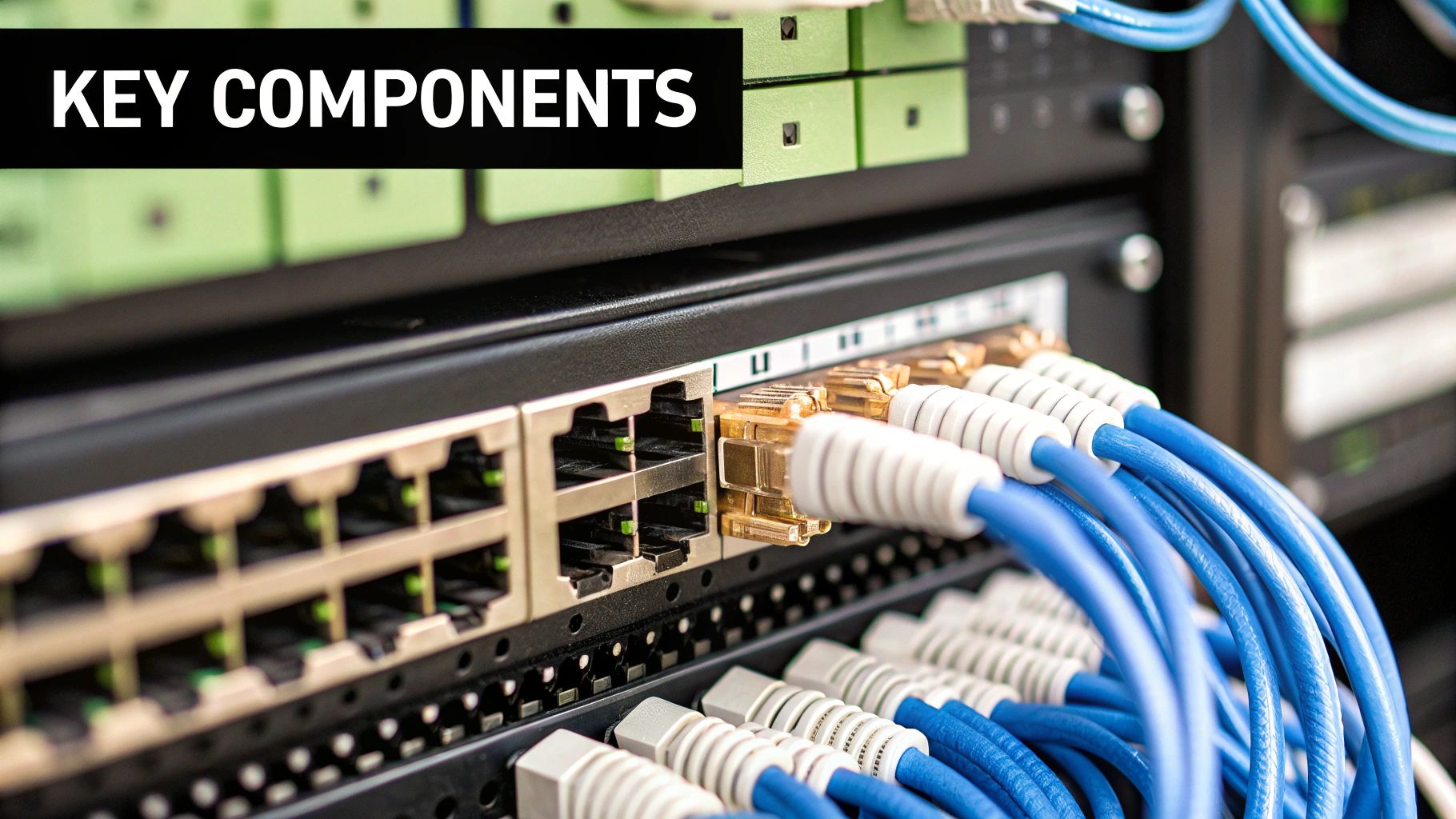
Unlocking Seamless Scalability
One of the biggest headaches for a growing business is how the office infrastructure keeps up. With messy point-to-point wiring, adding a new desk or a new team member can turn into a mini construction project, involving costly and disruptive work to pull new cables.
Now, picture this: your company is hiring 50 new employees next month. In a structured cabling environment, this isn’t a crisis; it’s business as usual.
- The Setup: Every desk already has data ports, all neatly wired back to a central patch panel in your server closet.
- The Action: To activate a new workstation, a technician simply plugs a short patch cord from the network switch into the corresponding port on the panel. Done.
- The Result: What could have taken days of disruptive work now takes mere minutes per employee. No drilling, no pulling cables through ceilings, and no interruptions for your current staff.
This “plug-and-play” approach ensures your physical network never holds back your company’s growth.
Slashing Downtime and Troubleshooting Costs
We’ve all seen it: the dreaded “spaghetti closet.” When a connection fails in that mess, an IT technician has to play detective, spending hours manually tracing a single unlabeled cable through a chaotic bundle. All the while, a critical employee or an entire department is offline, unable to work.
A structured system flips the script. Every single cable, port, and connection is labeled and documented.
Think about what downtime really costs. When your sales team can’t connect, every minute your IT tech spends hunting for a bad cable is a minute of lost revenue. A structured system turns that chaotic, hours-long search into a quick, methodical fix.
When a user reports an issue, a technician can walk straight to the telecommunications room, find the exact labeled port, and test the line. Problems are isolated and fixed in a fraction of the time. This kind of efficiency is fundamental, and you can learn more about how to improve network performance by starting with these foundational upgrades.
Creating a Future-Ready Foundation
Technology moves fast. The network that works perfectly for you today might be a bottleneck in five years. A system wired just for today’s needs is a nightmare to upgrade for higher-speed Ethernet or new Power over Ethernet (PoE) devices like advanced cameras and access points.
A properly planned structured cabling system is an investment in your future. By installing a higher grade of cable than you immediately need—like putting in Cat6a when you only require 1 Gbps speeds today—you’re building in capacity for what’s next.
When the time comes to upgrade your switches and routers for faster speeds, the most expensive and disruptive part—the cabling—is already done. This foresight transforms a massive future overhaul into a simple hardware swap, saving you an enormous amount of money and disruption down the road. It’s one of the smartest long-term investments you can make to keep your business agile and competitive.
A Look Under the Hood: Cabling Components and Standards
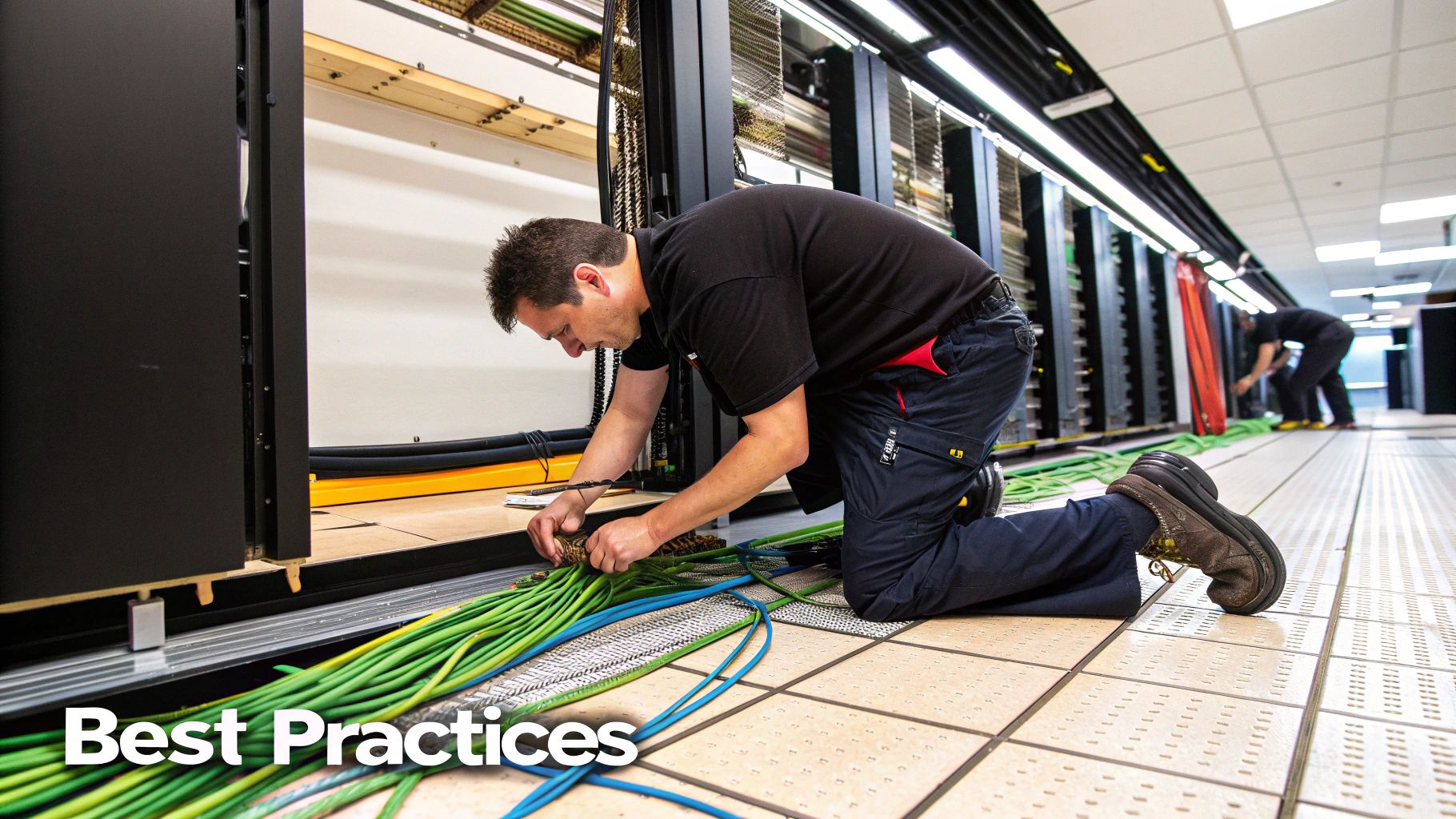
A dependable network isn’t just a bunch of wires plugged in haphazardly. A truly robust structured cabling system relies on two things: the physical hardware that moves data and the industry standards that make sure every piece plays well together.
Think of it like building a house. The components are your high-quality lumber, pipes, and electrical wiring. The standards are the non-negotiable building codes that dictate how everything gets connected to ensure the structure is safe, functional, and won’t fall down. Let’s pull back the curtain on the hardware and the rules that create this digital foundation.
The Core Hardware Components
While a full system has many small parts, a few key pieces do the real heavy lifting. These are the workhorses that manage and direct information across your entire network, from the central server room to every single desk.
- Network Switches: These are the active traffic cops of your network. A switch is a smart device that takes an incoming data packet and sends it only to its intended destination. This clever routing prevents unnecessary data from flooding your network and slowing everyone else down.
- Patch Panels: If a switch is the traffic cop, the patch panel is the central telephone switchboard. It’s a simple, passive hub where all the long-run cables coming from wall outlets terminate in one organized place. Using short “patch cords,” a technician can then easily connect any wall port to a switch port to activate it. This makes adds, moves, and changes a breeze.
- Cabling: The cables are the actual highways for your data. Just as you have different roads for local streets versus interstate travel, there are different types of cables designed for specific needs and distances.
Choosing the Right Cable Type
Selecting the right type of cable is one of the most important decisions you’ll make. It directly impacts your network’s speed today and its ability to handle new technologies tomorrow. The main contenders for modern businesses are copper twisted-pair and fiber optic cables.
| Cable Type | Common Use Case | Key Advantage |
|---|---|---|
| Category 6 (Cat6) | Standard office networks for computers, printers, VoIP phones. | Provides solid 1 Gbps speeds, perfect for many small to medium-sized businesses. |
| Category 6a (Cat6a) | Higher-performance networks, Wi-Fi 6 access points, and future-proofing. | Supports 10 Gbps speeds over longer distances, offering excellent longevity for your investment. |
| Fiber Optic | High-demand data centers, backbone links between server rooms or buildings. | Delivers incredible bandwidth, is nearly immune to interference, and can send data for miles. |
For most businesses, Cat6a hits the sweet spot between cost and future-readiness. But for truly massive data loads, like those in AI, fiber is the only option. To give you some perspective, a single high-capacity NVIDIA AI data center can contain a staggering 1,728 fibers in just one backbone cable to manage the torrent of information.
The Power of Industry Standards
So, what stops a network from becoming a chaotic mess of incompatible parts from a dozen different vendors? The answer lies in industry standards, primarily set by organizations like the Telecommunications Industry Association (TIA) and the Electronic Industries Alliance (EIA).
These standards are the universal rulebook for the IT industry. They guarantee that a patch panel from one company will work perfectly with a cable from another, and that both will deliver the performance you paid for.
These rules govern everything from the color code of the tiny wires inside a cable to the maximum length of a cable run. Following them is what separates a reliable, high-performance network from a constant source of frustration. For any serious project, working with professional structured cabling installers who live and breathe these standards is the only way to ensure your network is built right and built to last.
How Structured Cabling Powers Modern Industries
It’s one thing to talk about organized wires and standards, but the real power of structured cabling comes to life when you see how it solves real-world problems. This isn’t just about tidying up a server closet; it’s about building a reliable foundation that can handle the unique pressures of any environment.
https://www.youtube.com/embed/gb9BeIfQv-E
From a fast-paced corporate office to a life-or-death hospital setting, a well-planned cabling system is the unsung hero that keeps everything running smoothly. While the core principles are the same, the priorities—whether it’s lightning-fast speed, bulletproof reliability, or sheer scalability—change dramatically from one industry to the next.
The Corporate and Educational Backbone
Think about a large university campus or a corporate headquarters spread across multiple floors. The one constant is change. Employees come and go, teams are shuffled, and entire departments get reconfigured.
With a structured cabling system, these moves are no longer a massive headache. Instead of calling in electricians to pull new wires through the walls for every new desk, the IT team can simply activate or deactivate data ports from a central location. This means reconfiguring an entire floor can be done in minutes, not days.
The core benefit here is operational efficiency. Instead of treating every office move like a construction project, the network is ready for any change, allowing the organization to focus on its mission—whether that’s education or business growth.
This kind of adaptable infrastructure is the bedrock for any serious digital strategy. It’s a key piece of the puzzle when it comes to IT modernization for SMBs and larger enterprises alike, supporting everything from VoIP phone systems and security cameras to the Wi-Fi that everyone depends on.
High-Stakes Environments: Data Centers and Healthcare
In some fields, the demands on the network are far more intense. For a massive data center or a modern hospital, basic connectivity isn’t enough. They need extreme performance and absolute reliability, where even a moment of downtime can have serious consequences.
Data Centers: The Need for Speed
Modern data centers are the engines of our digital world, especially those built for AI. They’re not just storing data; they’re processing it at an incredible rate. To make this happen, they need connections with massive bandwidth and incredibly low latency.
For example, a single NVIDIA AI data center might rely on backbone cables containing over 1,700 fiber strands to link thousands of powerful GPUs. A messy, point-to-point wiring mess would simply melt under that kind of pressure. Structured fiber optic cabling is the only realistic way to create the clean, high-density pathways needed to handle that firehose of information.
Hospitals: Where Reliability is Life or Death
In a hospital, a network failure isn’t an inconvenience—it can be a genuine crisis. Critical systems like patient heart monitors, digital medical records, and MRI machines all depend on a stable, always-on connection.
Structured cabling provides the redundancy needed to ensure a single faulty cable doesn’t take down an entire wing. Because every connection is organized and clearly labeled, a technician can find and fix a problem in minutes, not hours. That speed can make all the difference when lives are on the line.
Structured Cabling Application by Industry
The following table breaks down how structured cabling meets the unique demands of various sectors, highlighting the specific requirements and benefits for each.
| Industry | Primary Requirement | Key Benefit of Structured Cabling |
|---|---|---|
| Corporate Office | Agility and Flexibility | Rapidly supports office moves, adds, and changes with minimal disruption. |
| University Campus | Scalability and Coverage | Easily manages a large, transient user base across multiple buildings. |
| Data Center | Extreme Bandwidth | Enables massive data throughput for high-performance computing and AI. |
| Hospital | Absolute Reliability | Provides redundant, fault-tolerant connections for critical patient care systems. |
As you can see, the “why” behind structured cabling changes with the environment, but its value as a strategic asset remains constant across the board.
Planning a Successful Cabling Installation
When you decide to install or upgrade your structured cabling, you’re not just running wires; you’re building the digital foundation of your business. This is a serious investment, one that should support your operations for the next decade, not just the next year. Success all comes down to a smart strategy that anticipates the future.
The first step is always a deep dive into your real needs. Before anyone even thinks about pulling a cable, you have to get a handle on your current and future bandwidth demands. Don’t just count the computers you have today. Think about the high-definition security cameras, the next-generation Wi-Fi access points, and the countless IoT devices you’ll be adding over the next five to ten years. One of the biggest and most expensive mistakes I see is businesses underestimating their own growth.
Designing Your Network Blueprint
With a clear picture of your requirements, you can start creating a detailed blueprint. Think of this as the architectural plan for your network. It maps out everything: where the cables will run, how the equipment room will be laid out, and the exact placement of every single data outlet. A critical part of this design is incorporating effective cable management strategies from the very beginning to keep things organized and cool.
This planning phase is also where you make crucial choices about the cables themselves. Can you get by with standard Cat6, or is it smarter to invest in Cat6a to future-proof your network? This blueprint becomes the master guide for your installers and an invaluable document for any future troubleshooting or upgrades.
A well-documented cabling plan isn’t optional—it’s essential. It’s what separates a quick, five-minute fix from a day-long troubleshooting nightmare. Meticulous labeling of every cable, port, and patch panel is your best insurance policy against expensive downtime.
Executing the Installation
Once your plan is locked in, the installation phase is all about precision. This is absolutely not the time to cut corners with subpar materials or an inexperienced crew. There’s a reason the global structured cabling market was valued at $14.03 billion in 2024 and is expected to hit $22.37 billion by 2029—quality infrastructure is no longer a luxury, it’s a necessity. You can see more on these trends in this structured cabling growth report.
Picking the right installation partner is probably the most important decision you’ll make. A certified, professional installer brings a few non-negotiable benefits to the table:
- Following the Rules: They live and breathe the strict TIA/EIA standards, which is your guarantee of performance and reliability.
- Expert Craftsmanship: They know how to terminate every connection perfectly and route cables to avoid signal interference and other gremlins.
- Proof of Performance: After the job is done, they’ll use specialized gear to test every single line, certifying that it performs exactly as it should.
A truly successful installation is one that just works, quietly and reliably, letting you focus on your business. To get a closer look at the process, explore our guide on how to install data cabling for optimal network performance. By investing in solid planning and professional work, you’re building a powerful, scalable network that will serve you well for years.
Answering Your Structured Cabling Questions
Even when you see the clear advantages, it’s natural to have practical questions before signing off on a new installation. Let’s tackle some of the most common things business owners and IT managers ask. Getting these answers helps you build a solid business case for moving to a modern, organized network.
The goal here is to give you straight, honest answers to set the right expectations for your project. This isn’t just about the tech—it’s about making a smart financial and operational move for your company’s future.
How Much Does a Structured Cabling Installation Cost?
There’s no single price tag for a structured cabling project. The final cost really depends on a few key things: the size of your building, how many connection points (or “drops”) you need, the type of cable you choose (like Cat6, Cat6a, or fiber), and what local technicians charge for labor. A small office might only run a few thousand dollars, while a large, multi-story building will be a much bigger investment.
It’s helpful to think of this as a long-term capital investment, not just another IT expense. Sure, the upfront cost is higher than just running cables as you go, but you get that money back over time. How? Through far less downtime, easier troubleshooting, and the ability to expand without starting from scratch. Always get detailed quotes from a few certified installers to see how they stack up.
What Is the Lifespan of a Structured Cabling System?
A professionally installed system is built to last. We’re talking 10 to 20 years, sometimes even longer. The physical cables, jacks, and panels are incredibly durable and almost never fail on their own.
The real factor that determines a system’s lifespan isn’t physical wear and tear—it’s the evolution of technology. This is why “future-proofing” is so important. By installing a better cable than you need right now (like choosing Cat6a even if you only run a 1Gbps network), you’re preparing your building for the faster speeds of tomorrow. It saves you from having to rip everything out and start over down the road.
Can I Upgrade My Existing Disorganized Network?
Absolutely. One of the most common projects we see is cleaning up an old, messy “spaghetti” network and replacing it with a clean, structured system. It’s a game-changer for reliability and management.
The process usually starts with an audit of what you have now and what you’ll need in the future. From there, old wiring is carefully removed, and new, organized pathways, patch panels, and neatly labeled cables are installed. This kind of upgrade can often be done in stages or after hours to keep your business running smoothly, leaving you with a dependable network that’s ready for anything.
Ready to build a network foundation that grows with your business? Clouddle Inc specializes in designing and deploying high-performance structured cabling solutions tailored to your specific industry needs. Get in touch with our experts today to plan your next infrastructure upgrade.


